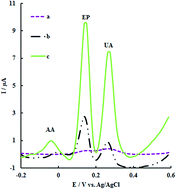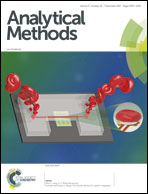Selective analysis of epinephrine in the presence of uric acid by using an amplified electrochemical sensor employing a gold nanoparticle decorated cysteic acid film
Abstract
In the present work, an effective electrochemical sensor for the rapid and selective determination of epinephrine (EP) in the presence of uric acid (UA) based on a glassy carbon electrode (GCE) modified with gold nanoparticles (AuNPs) and cysteic acid was applied. This modified electrode exhibited a potent and persistent electron mediating behavior followed by well separated oxidation peaks of EP and UA. The surface and electrochemical characterization of the modified electrode was performed by field emission scanning electron microscopy (FESEM), chronocoulometry (CC), cyclic voltammetry (CV) and differential pulse voltammetry (DPV). The effective surface area (0.087 cm2) which is 4.8 times as much as that of the unmodified GCE, electron transfer coefficient (α = 0.31) and number of electrons involved in the rate determining step (nα = 2.2 ≈ 2) for EP were also determined using electrochemical approaches. Under optimal conditions, the AuNPs/cysteic acid/GCE displays a linear response for 0.4–11.7 μM EP and a good detection sensitivity of 1.2631 μA μM−1 and the detection limit is 80 nM (S/N = 3). The suggested sensor was successfully used for the determination of analytes in real samples with satisfactory results.



 Please wait while we load your content...
Please wait while we load your content...